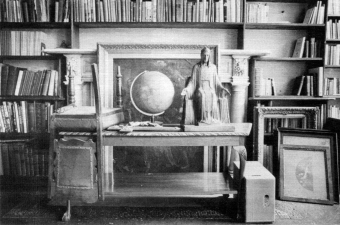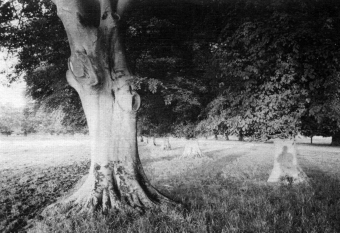
Michael Flecky, S.J.: 'Hopkins in Ireland'
A Review by Susan R. Lawler
Theology Department
This past September Creighton's Fine Arts Department hosted a remarkable photography exhibit entitled "Hopkins in Ireland."
The artist, Michael Flecky S.J., Associate Professor of Fine Arts, arranged 8 x 12" black and white prints in thematic clusters accompanied by carefully selected texts from Gerard Manley Hopkins' poetry, journals, and letters. The texts hung beneath the pictures were not captions to the photographs nor were the photographs illustrations of the texts. Rather, Flecky created a meditative experience, in which the viewer/reader interacting with photography and text had a richer experience than either photograph or text alone could render.
Flecky stated that his objective in making these images and associating them with texts was to offer a representation of Hopkins in Ireland "as a visual artist with an interest in how pictures might illuminate the manuscripts of Gerard Manley Hopkins' personal and spiritual life in this the 150th anniversary of his birth." Hopkins was a Jesuit, classicist, occasional amateur sketch artist and poet in Victorian England. Although his poetry, published in 1918 almost 30 years after his death, was neither well known nor well accepted during his lifetime, it gradually became a major influence in 20th century English poetry. Some claim it to have been the most forward-looking of its era.
 |
||||
| Photo by Michael Flecky, S.J. | ||||
His poetry reveals him to have been one who looked at nature closely, carefully and prayerfully, sensing a transcendent energy and presence in the natural world about him. His genius is in combining a Darwinian, Ruskinian naturalism with Ignatian spiritual contemplation. This exhibit lets us in on a part of that world of Hopkins, the last years, which were spent in Ireland. It is not a travelogue of Hopkins' Ireland; rather it is an imaging of the places and spaces associated with his Ireland in such a way that the viewer might also see in these scenes that sacred energy that Hopkins probably felt. The success of this show is due not only to Flecky's exquisite craftsmanship in photography, but also to his sharing much of the same spiritual tradition and poetic eye as Hopkins.
Many of the pieces in the first segment of the exhibit depict the more intimate places and interior spaces of Hopkins' daily life. These are the nearby places where he lived, wrote, read, monitored exams, looked through windows, climbed stairs, stored greenhouse equipment, strolled and prayed. These carefully composed arrangements of light, space and material express a wide range of Hopkins' moods and insights. There is one, for example, entitled Examination Hall, University College, Dublin. It is a large, high ceilinged, somber space with many irregularly lined folding chairs in front of a stage. The single chair on the stage overlooking the room is overturned. It is dim, sterile, lonely and cold, a "joyless space." The time spent there teaching and monitoring exams was not pleasant for Hopkins. This image evokes the sad isolation he felt.
 |
|||
| Photo by Michael Flecky, S.J. | |||
A totally different sort of photograph among these is one of a garden wall. On this relatively small segment of an old richly textured, crumbling stuccoed wall are random swatches of paint, the sort one makes in the process of cleaning a paint brush. There are also leafy vines and a black drain pipe emerging from an upper corner. This abstract collection of texture and tones is the sort of stuff that would have caught a visually poetic eye but would elude the less observant. It is a fine example of the photographer's, as well as Hopkins', attentiveness to beauty.
The many views into and through windows, doors, stairwells and gates keep the eye moving, following the light, inside and out and sometimes back inside oneself. They are filled with "instress," a power that provokes connections. This movement outwards and inwards is characteristic of Hopkins' spirituality. One of the many texts of the show describes this quality of Hopkins' vision through his often used words "scape" and "inscape. He meant by these that each individual reality comes from and exists as a unique clustering of energies and stresses from One Being. Each scape has the possibility of being inscaped (i.e., of being touched and changed by the act of being viewed) and then touching the viewer in return. However, to be so touched, one must look carefully and reflectively.
Two of the magnificent landscapes contain the shadow of the photographer. These images render and illustrate Hopkins' belief that "what you look hard at seems to look hard at you." He means you must really look at nature, let it look back, let it touch you, let it recreate you for, as his most well known poem begins, "the world is charged with the grandeur of God."
The majority of the photographs in this show are of landscapes and treescapes. These are the very sort of places and spaces where Hopkins faced these inscapes and created his "instress," the particularly personal response of creative activity in word or in picture. Flecky's trees are many. There are leafed ones and empty ones, dead ones and vibrant ones, gnarled ones and slick ones. They are metaphors for sacred structures, moments, and places where Hopkins saw and was touched by God's life-filling presence.
 |
||||
| Photo by Michael Flecky, S.J. | ||||
These metaphors are expressed richly and variously by Flecky's masterful use of light, sometimes barely kissing the bark, or creating a silhouette, other times sparkling forth off the leaves or allowing the viewer to look up through the translucent canopy. Each use of light nuances the metaphor differently. A felled tree evokes mournful loss in the whacking and hacking that destroys its tender grandeur. Autumn leaf-loss is twined with personal grief. And "Pleasure Grounds," a portrait of three grand trees standing like sentinels of a sacred, sylvan space, is a magnificent expression of that deep-down beauty that Hopkins' eye-soul looked into and through to see both God and himself stressed, inscaped, embraced.
The landscapes are many and moody. There are the dark, doleful, zigzaggy Cliffs of Moher, a lonesome hillside footpath beside the sea, sparkling, lyrical streams, serene pastoral scapes, manicured stately grounds, and the city parks of ordinary folk. These pieces present a delicious feast for the eye. Flecky has successfully expressed the inscape of things. They are so lovely that they make it all too obvious why Hopkins saw in the natural world around him that "all things are charged with love, are charged with God."
I was saddened that the show eventually had to come down. It not only filled the gallery with remarkable beauty, it also turned it into a spirited space. People did not dart through this show. They moved slowly, carefully, and thoughtfully, along the walls looking, reading, reflecting. And when they left, they had been touched, and had created their own spiritual inscapes. One visitor to the gallery remarked that the show had been a sacramental experience for him.
One of the texts hung as part of the show, intending to express what Hopkins the poet achieved, could equally express what Flecky the photographer achieved with this show. "The artist is the man who goes out into the empty spaces between man and God and takes the enormous risk of attempting to create in that vacancy a new fabric of connections between man and divine power."